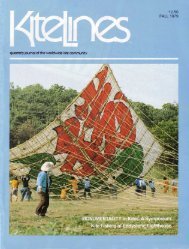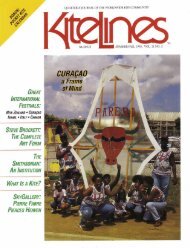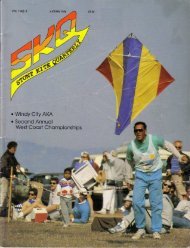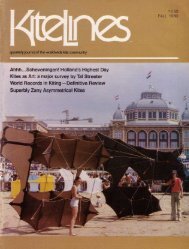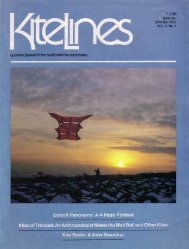Kite Lines - Vol.3 No. 1 - KiteLife
Kite Lines - Vol.3 No. 1 - KiteLife
Kite Lines - Vol.3 No. 1 - KiteLife
- No tags were found...
You also want an ePaper? Increase the reach of your titles
YUMPU automatically turns print PDFs into web optimized ePapers that Google loves.
Sirs :I wasencouragedto forward my"Facet <strong>Kite</strong>" design toyou so that others might enjoyflying this new cellular kite . If this ,kite encourages others to explore thepossibilities of this construction, I'd loveto hear of any hybrids which result .Stephen J . Robinson7 Hastings Close, Newbold VillageChesterfield, Derbyshire, S41 8RH, EnglandDATE OFPOSTMARK :FEBRUARY 19, 1979Comment by Curtis MarshallStephen Robinson's Facet <strong>Kite</strong> is of thesame family as Peter Waldron's Prof . Waldofdesign-but appears to lend itself moreeasily to the whims of the imaginativefabricator .The Facet <strong>Kite</strong>, as presented byRobinson, is actually the basic approachto a whole series of applications-triangular,square, pentagonal, hexagonal, etc .After studying the plan, I decided to buildthe square version since it seemed the leasttime-consuming . The material was 34-ouncerip-stop nylon with 1/4-inch plastic curtainrings sewn in at each point instead of thesplit rings in the plan . For the corners, Iused 3/.-inch-thick nylon disks drilled radiallyat 90 degrees . Lightweight 5 /, d-inchdia . dowels were used instead of the areinch dia . ones indicated . Assembly presentedno problems .The kite is not for light wind andshould be looked upon as usable in moderateto high winds, probably 8 to 20knots . It exhibits a surprising stabilityonce there is sufficient breeze to keep italoft . It flies at a low angle in a moderatebreeze, but climbs to about 70 degreeswith gusts of 12 to 15 knots. There is no"glide effect" and the kite drops suddenlyas soon as the wind slacks off. Althoughperformance is good with either a two- orthree-leg bridle, the length of the bridlelegs must be about equal and close to 36inches each .Successful extrapolation of the designwould seem to require careful attentionto the ratio of weight to wing area . Itwould be altogether too easy to becomeengrossed in the geometry and to forgetthat the cells must not become disproportionatelysmall . This would increase notonly weight but also drag while providingno increase in lift . <strong>No</strong>netheless, I thinkthat it would be intriguing to try this kitedesign with a reduction of 4 :1 as well aswith an increase of 1 :4 . Size alterationsof these magnitudes would probably offersome challenge and provide entertainmentwell into the wee small hours, not to mentionconsumption of calculator batteries .






